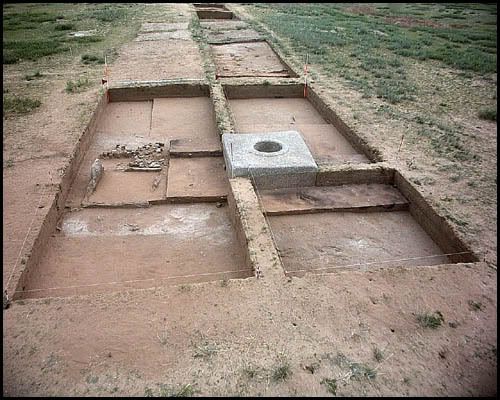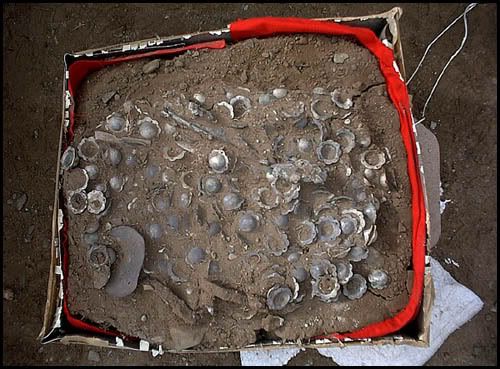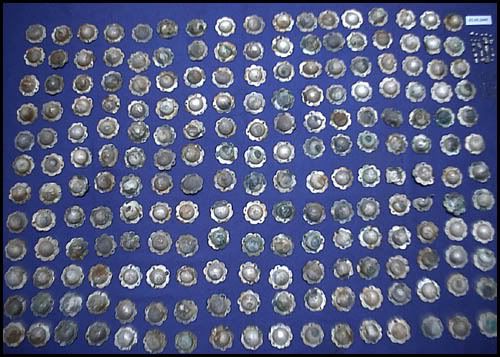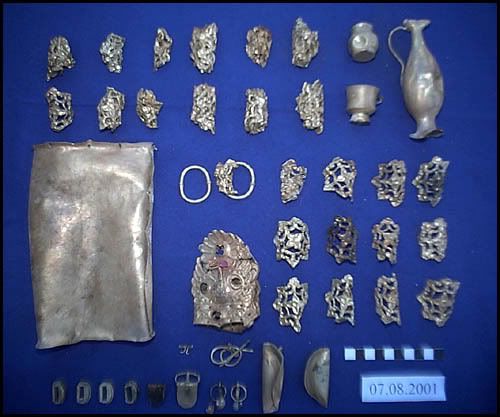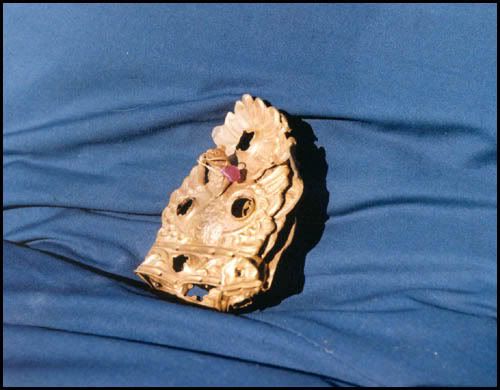Post by aca on Dec 4, 2006 22:47:34 GMT 3
Khosho Tsaidam
The Khosho Tsaidam Turkic monuments are made up of four memorial complexes, including those erected in honour of Bilge Khan, a famous politician of the Eastern Turkish Empire (d. 734), and Kul Tegin, commander-in-chief of the Turkic armed forces and younger brother of Bilge Khan (d. 731).
The Khosho Tsaidam memorials are the most important known archaeological remains of the Turkic Empire, which extended across Central Asia in the 6th -8th centuries AD. The unique information presented in the inscriptions on the steles located here has proven extremely valuable to the study of Central Asian history and culture; in addition, the memorial sites have supplied particular insight into the world view, religious beliefs, architecture, arts, literary development and political relations of the early Central Asian peoples.
In terms of their external and internal structure, these first two memorials are essentially identical, consisting of three sections: an entrance area, containing a stele with Tukic runes and Chinese characters, mounted on a granite pedestal fashioned in the form of a turtle; a prayer temple; and a section containing an altar-stone. However the memorials differ in relation to the human and animal statues and the arrangement of the buildings they contain, as well as in terms of their state of preservation. The remaining two memorials contain stones engraved with flower and bird figures, but it is unknown to whom these are dedicated. These smaller memorial complexes also include the remains of surrounding walls and moats, engraved square stone fences, human and animal statues, and bal-bal stones, as well as traces of a former temple.
Although the dates of the Bilge Khan and Kul Tegin memorials are clearly recorded, there is nothing stated in historical sources about the other memorials located nearby. However, as a result of archaeological studies and investigations, it is possible to say that all of them were built during the same approximate time period, considering the similarity of their designs, structure, and customs. Thus, many scholars have concluded that the monuments were established in the 730s in honour of Turkic kings and aristocrats, and were destroyed by Uighurs only about ten years after their establishment. The Uighurs broke down nearly everything including the figures of the king and his attendants.
Recent excavations at the Khushuu Tsaidam site have led to the discovery of many interesting objects, including two headless sheep statues from the entrance to the Bilge Khaan memorial; the broken half-torso of a human statue made of coarse white granite, with missing head and right arm, holding a flat object in the fingers of the left hand, situated between the turtle stone and the offering-temple; a golden crown ornamented with the figure of a mythical bird; gold and silver containers; and a silver deer figure.
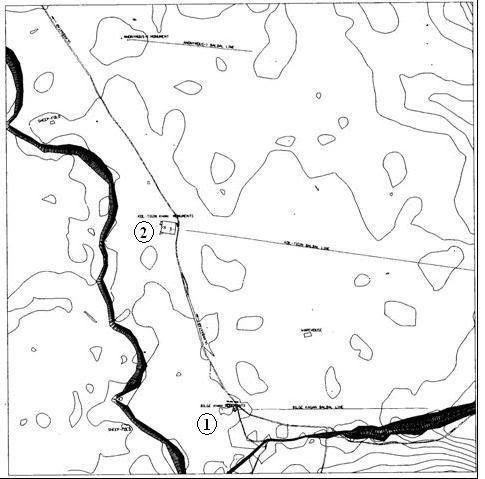
*(1) - Bilge Khagan's memorial complex; (2) - Kul Tigin's memorial complex
Bilge Khan Memorial
Mogilyan, son of the Turkic Khan Ilteris, was born in 683. He became leader of the Turks in 716 and was accorded the title of "Bilge", meaning "Wise". During his reign he made significant contributions to the economic and cultural development of the Turkic Empire. Bilge Khan died on February 25, 734, and a sacrificial temple built in his honour was constructed on June 22 of the following year.
The memorial complex is surrounded by a square wall measuring 96 x 60 metres, inside of which are the traces of a moat. In the western part of the central enclosed area there is a square-shaped sacred stone (2.4 x 1.2m), and in the centre of the complex are located the square foundations of the former sacrificial temple. A white marble turtle monument is located in the eastern part of the area. The central part of the monument has a compressed earthen floor, with a thickness of 40 cm. So-called " balbal " stones extend eastwards in a line from the stele installed on the back of the turtle monument for about 3 km. These stones are believed to correspond either to the number of enemies exterminated by the hero, or alternatively to the number of people who participated in the funeral ceremony.
The most impressive element of the Bilge Khan memorial is its runic stele, which has broken apart into three pieces but remains highly legible. The top of the monument is decorated with the figure of a twisting dragon, while the front is decorated with the figure of an ibex, apparently the totemic symbol of Turkic khans. The principal text of the stele describes the ancestry, honours and achievements of Bilge Khan; on the rear face of the monument there is also a message of condolence sent by the Tan Emperor, inscribed in Chinese characters. The memorial complex further includes several human statues, among which are the carved statues of a man and woman seated in a cross-legged position, assumed to represent Bilge Khan and his queen. The heads of these monuments were all cut off by the Uighurs at the time of their conquest of the Turkic Empire.

*(1) - several human & other statues; (2) - sacrificial temple; (3) - altar
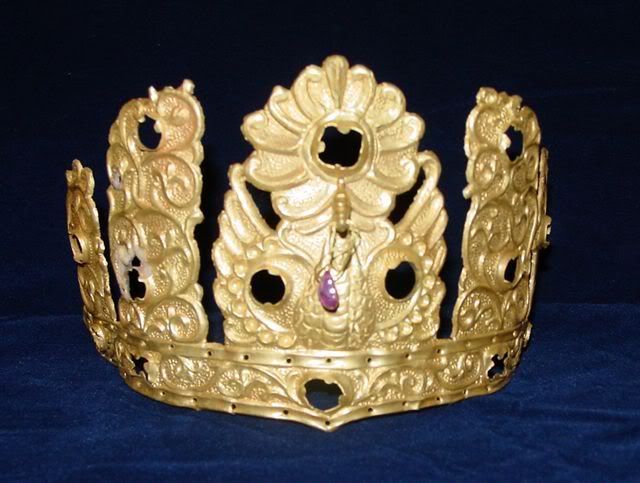
Bilge-khagan's crown found at the site
Kul-Tegin Memorial
Kul Tegin was born in 684 as the youngest son of Ilteris, the Turkic King. He began taking an active political role from the age of 16. He also played an important role in raising his brother to the rank of king. Kul Tegin devoted all his strength to developing and implementing political, economic and international relations policies of the Turkic empire. He passed away on February 27, 731 and was interred on November 2 of the same year. The memorial temple was completed on August 1, 732 . It is noted in historical sources that the funeral ceremony was an impressive one, attended by numerous representatives from all over the world.
In the centre of the memorial complex, there was a sacrificial temple measuring 10 x 10 metres, built upon a special stage. Its walls were covered with white adobe and were painted red, with coloured murals on the inner walls. The remains of 16 pillars, which formerly supported the roof of the temple, are still preserved. The area surrounding the temple was paved with square bricks measuring 32 x 32 x 6 cm. This brick floor was surrounded by square walls measuring 67 x 29 m, which in turn were surrounded by a moat. In the western wall, there were 2.9 metre-wide gates. Two stone sheep were placed on either side of the gate. There is a turtle monument 8 metres within the gates, which formerly supported a stele with runic and Chinese inscriptions. This stele had fallen down and broken into pieces, but was located and restored in 1911.In the area between the gates and the worship-temple, there were figures of attendants and members of Kul-Tegin's entourage, placed in two lines facing one another. The heads of these statues are missing, presumably having been cut off by the Uighurs during their attack on the Turks. Inside the temple, there were originally placed the cross-legged figures of Kul-Tegin and his wife, of which only very basic remains are extant. During the course of excavations in 1958, the heads of Kul Tegin and his wife were found. A row of approximately one thousand "balbal" stones extends for about 3 kilometres from the gates.
The most significant element of the Kul-Tegin monument is the stele located within the complex, measuring 3.33 x 1.32 x 0.46 m. The top of the monument is decorated with two dragons; further down is a wild goat, totem of the Ashina tribe. Covering three sides of the monument, there are a total of 68 lines of script containing approximately one thousand runic characters. The stele was originally erected on the back of the nearby turtle monument, with its front side - showing the totemic symbol - facing the direction of the rising sun. The stele actually contains several separate inscriptions which were carved at different times. The main text was inscribed over a period of twenty days on Kul-Tegin's orders, by his grandson Yolug. On the rear of the monument were inscribed the words of condolence sent by the Tan Emperor Min-Huan. Two smaller inscriptions were later added to the side of the monument containing Chinese characters.
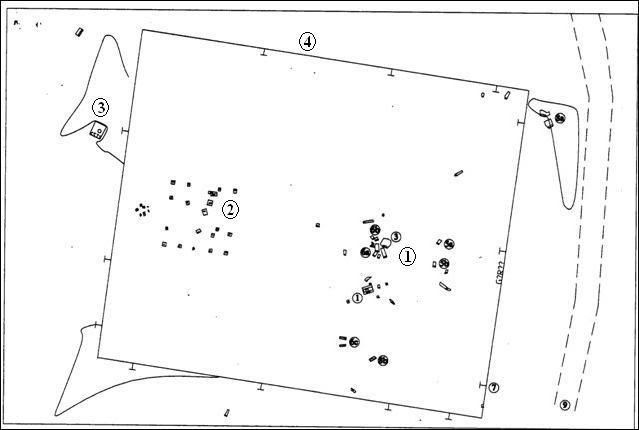
*(1) - broken statues; (2) - sacrificial temple; (3) - altar; (4) - traces of square walls and moat
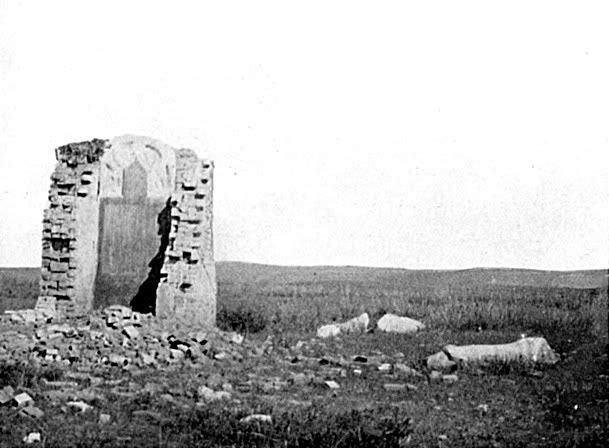
From Kul-tigin's memorial complex
The Khosho Tsaidam Turkic monuments are made up of four memorial complexes, including those erected in honour of Bilge Khan, a famous politician of the Eastern Turkish Empire (d. 734), and Kul Tegin, commander-in-chief of the Turkic armed forces and younger brother of Bilge Khan (d. 731).
The Khosho Tsaidam memorials are the most important known archaeological remains of the Turkic Empire, which extended across Central Asia in the 6th -8th centuries AD. The unique information presented in the inscriptions on the steles located here has proven extremely valuable to the study of Central Asian history and culture; in addition, the memorial sites have supplied particular insight into the world view, religious beliefs, architecture, arts, literary development and political relations of the early Central Asian peoples.
In terms of their external and internal structure, these first two memorials are essentially identical, consisting of three sections: an entrance area, containing a stele with Tukic runes and Chinese characters, mounted on a granite pedestal fashioned in the form of a turtle; a prayer temple; and a section containing an altar-stone. However the memorials differ in relation to the human and animal statues and the arrangement of the buildings they contain, as well as in terms of their state of preservation. The remaining two memorials contain stones engraved with flower and bird figures, but it is unknown to whom these are dedicated. These smaller memorial complexes also include the remains of surrounding walls and moats, engraved square stone fences, human and animal statues, and bal-bal stones, as well as traces of a former temple.
Although the dates of the Bilge Khan and Kul Tegin memorials are clearly recorded, there is nothing stated in historical sources about the other memorials located nearby. However, as a result of archaeological studies and investigations, it is possible to say that all of them were built during the same approximate time period, considering the similarity of their designs, structure, and customs. Thus, many scholars have concluded that the monuments were established in the 730s in honour of Turkic kings and aristocrats, and were destroyed by Uighurs only about ten years after their establishment. The Uighurs broke down nearly everything including the figures of the king and his attendants.
Recent excavations at the Khushuu Tsaidam site have led to the discovery of many interesting objects, including two headless sheep statues from the entrance to the Bilge Khaan memorial; the broken half-torso of a human statue made of coarse white granite, with missing head and right arm, holding a flat object in the fingers of the left hand, situated between the turtle stone and the offering-temple; a golden crown ornamented with the figure of a mythical bird; gold and silver containers; and a silver deer figure.

*(1) - Bilge Khagan's memorial complex; (2) - Kul Tigin's memorial complex
Bilge Khan Memorial
Mogilyan, son of the Turkic Khan Ilteris, was born in 683. He became leader of the Turks in 716 and was accorded the title of "Bilge", meaning "Wise". During his reign he made significant contributions to the economic and cultural development of the Turkic Empire. Bilge Khan died on February 25, 734, and a sacrificial temple built in his honour was constructed on June 22 of the following year.
The memorial complex is surrounded by a square wall measuring 96 x 60 metres, inside of which are the traces of a moat. In the western part of the central enclosed area there is a square-shaped sacred stone (2.4 x 1.2m), and in the centre of the complex are located the square foundations of the former sacrificial temple. A white marble turtle monument is located in the eastern part of the area. The central part of the monument has a compressed earthen floor, with a thickness of 40 cm. So-called " balbal " stones extend eastwards in a line from the stele installed on the back of the turtle monument for about 3 km. These stones are believed to correspond either to the number of enemies exterminated by the hero, or alternatively to the number of people who participated in the funeral ceremony.
The most impressive element of the Bilge Khan memorial is its runic stele, which has broken apart into three pieces but remains highly legible. The top of the monument is decorated with the figure of a twisting dragon, while the front is decorated with the figure of an ibex, apparently the totemic symbol of Turkic khans. The principal text of the stele describes the ancestry, honours and achievements of Bilge Khan; on the rear face of the monument there is also a message of condolence sent by the Tan Emperor, inscribed in Chinese characters. The memorial complex further includes several human statues, among which are the carved statues of a man and woman seated in a cross-legged position, assumed to represent Bilge Khan and his queen. The heads of these monuments were all cut off by the Uighurs at the time of their conquest of the Turkic Empire.

*(1) - several human & other statues; (2) - sacrificial temple; (3) - altar

Bilge-khagan's crown found at the site
Kul-Tegin Memorial
Kul Tegin was born in 684 as the youngest son of Ilteris, the Turkic King. He began taking an active political role from the age of 16. He also played an important role in raising his brother to the rank of king. Kul Tegin devoted all his strength to developing and implementing political, economic and international relations policies of the Turkic empire. He passed away on February 27, 731 and was interred on November 2 of the same year. The memorial temple was completed on August 1, 732 . It is noted in historical sources that the funeral ceremony was an impressive one, attended by numerous representatives from all over the world.
In the centre of the memorial complex, there was a sacrificial temple measuring 10 x 10 metres, built upon a special stage. Its walls were covered with white adobe and were painted red, with coloured murals on the inner walls. The remains of 16 pillars, which formerly supported the roof of the temple, are still preserved. The area surrounding the temple was paved with square bricks measuring 32 x 32 x 6 cm. This brick floor was surrounded by square walls measuring 67 x 29 m, which in turn were surrounded by a moat. In the western wall, there were 2.9 metre-wide gates. Two stone sheep were placed on either side of the gate. There is a turtle monument 8 metres within the gates, which formerly supported a stele with runic and Chinese inscriptions. This stele had fallen down and broken into pieces, but was located and restored in 1911.In the area between the gates and the worship-temple, there were figures of attendants and members of Kul-Tegin's entourage, placed in two lines facing one another. The heads of these statues are missing, presumably having been cut off by the Uighurs during their attack on the Turks. Inside the temple, there were originally placed the cross-legged figures of Kul-Tegin and his wife, of which only very basic remains are extant. During the course of excavations in 1958, the heads of Kul Tegin and his wife were found. A row of approximately one thousand "balbal" stones extends for about 3 kilometres from the gates.
The most significant element of the Kul-Tegin monument is the stele located within the complex, measuring 3.33 x 1.32 x 0.46 m. The top of the monument is decorated with two dragons; further down is a wild goat, totem of the Ashina tribe. Covering three sides of the monument, there are a total of 68 lines of script containing approximately one thousand runic characters. The stele was originally erected on the back of the nearby turtle monument, with its front side - showing the totemic symbol - facing the direction of the rising sun. The stele actually contains several separate inscriptions which were carved at different times. The main text was inscribed over a period of twenty days on Kul-Tegin's orders, by his grandson Yolug. On the rear of the monument were inscribed the words of condolence sent by the Tan Emperor Min-Huan. Two smaller inscriptions were later added to the side of the monument containing Chinese characters.

*(1) - broken statues; (2) - sacrificial temple; (3) - altar; (4) - traces of square walls and moat

From Kul-tigin's memorial complex






